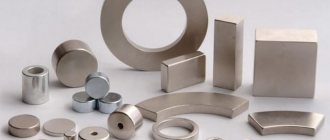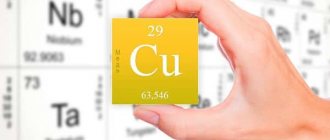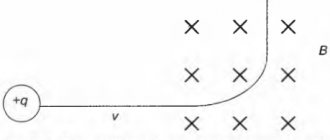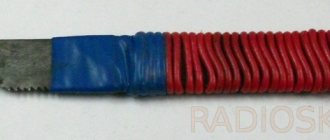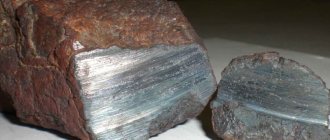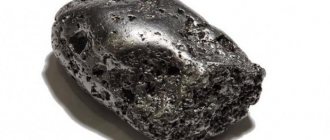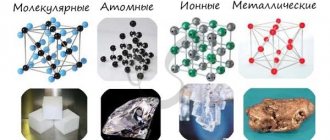Let's talk in a few words about what a neodymium magnet is and where it is used.
The magnetic properties of neodymium were discovered relatively recently, and the first products made from it appeared only in 1982. Despite this, she immediately began to gain popularity. The reason is the amazing characteristics of the alloy, capable of attracting iron objects hundreds of times its own weight and tens of times stronger than ferromagnetic devices. Thanks to this, equipment using neodymium magnets has become smaller in size, but at the same time much more efficient.
The alloy contains, in addition to neodymium, iron and boron. To obtain the desired product, these substances in powder form are not melted, but sintered, which leads to one significant drawback - fragility. A layer of copper-nickel alloy helps to get rid of chips and corrosion, thanks to which the product is ready for full use.
Measuring tool using magnets
Capro magnetic level
The use of a neodymium magnet in construction has made it possible to implement another very interesting application - as a level clamp. Indeed, when assembling and installing critical structural elements of a building, it is very important to maintain the angles, horizontal and vertical positions provided for by the design before fixing. These can be doors, windows, beams and floor slabs; after all, the reinforcement frame of a building requires that all the main reinforcing bars of the columns be installed strictly vertically. And, in addition, installing a fence or hedge, racks for grapes or a welded frame of a greenhouse made of metal elements, in all these operations a level with a magnet will be indispensable
Magnetic capro level
Most often, this level is used by professional builders, because a level with a neodymium magnet will have relatively little use in everyday life. But even for domestic use, this level will make many construction operations much easier and more convenient. After all, a level attached to a magnet allows you to adjust the position of the element being installed without any additional effort of holding it with your hand, while your hand remains free. The ease of use of the level combined with accurate measurement of the deflection angle makes such a tool extremely popular and necessary.
Search and collection of metal objects
Now you will not have problems finding iron objects that have rolled under furniture or fallen into a well. Simply attach, for example, a magnetic disk to the end of a stick or tie it to a cord and move this simple device over the place where the object is likely to fall. In just a few minutes, what you lost will be in your hands safe and sound.
The use of a neodymium magnet will also help to collect metal shavings or scattered screws. For convenience, wrap the neodymium item in a cloth, sock or plastic bag. This will help, on the one hand, to protect the work surface from the adhesion of iron debris, and on the other hand, to remove everything that is stuck at once and not separate each screw separately.
Nail holder
Neodymium magnets are traditional for the area of application and this is a relatively new type of auxiliary tool. Indeed, the ease of working with impact tools, the ease of fixing wooden parts and elements, and fastening other materials to wood make nails today one of the most popular types of fastening elements. On the other hand, when driving nails it often happens that the blow falls not exactly on the head of the nail, but on the fingers of the hand. This especially happens when small nails are used, which do not allow them to be held comfortably. The use of a tool such as a magnetic nail holder allows you to avoid injuries and at the same time significantly improve the quality of work. A plastic handle with a built-in neodymium magnet at the end will easily fix the nail and allow you to accurately install it at the installation site.
Nail holder
Holders
Talking about the areas where neodymium magnets are used in everyday life, we will mention various types of fasteners. With their help, you can hang any iron-containing objects on vertical surfaces: kitchen or plumbing utensils, gardening and any other tools. Simply mount the neodymium plates on the stand in a certain order and, if necessary, attach to them, for example, knives or screwdrivers.
The use of a neodymium magnet in everyday life is also possible for hanging non-iron objects: paintings, mirrors, shelves, mosquito nets, etc. To do this, fix a magnetic plate on the item, and a small sheet of iron on the surface where you plan to attach it.
As we have already said, the neodymium alloy is quite fragile, so it is undesirable to violate its integrity by drilling or cutting, as a result of which the properties of the metal will be significantly affected. It is better to choose neodymium magnets as suspensions, the use of which does not require additional processing. Fortunately, online stores offer products of a wide variety of configurations with holes of the required diameter, with various fasteners and cutouts. Therefore, you can easily select the device of the desired configuration. You can just as successfully use magnetic elements as a latch on a door, to attach a badge, or to create your own refrigerator magnet. This is not a complete list of areas where neodymium magnets are used.
Choosing a neodymium magnet
Choosing a neodymium magnet!
Let's try to understand the wide range of magnets!
Neodymium magnets, as you have already noticed, come in different sizes, shapes, brands, alloys, permissible temperature conditions of use, solving completely different problems.
First type
neodymium magnets denote large neodymium magnets disks. These are the most powerful magnets in terms of strength and radius of action of the magnetic field! The largest in the line is a 70x6 magnet, with an incredible maximum pull-out force of up to 300 kg! A magnet of a more compact size, which does not have such an impressive force, but is still an impressive 80 kg per pull, has a size of 45x25 mm. Such a magnet costs only 60 BYN with free delivery within the city and a discount on delivery within Belarus. The most inexpensive version of large magnets starts from 25 BYN and attracts with a force of up to 20 kg. We are talking about a 30x10 mm magnet.
Second type of magnets
– small neodymium magnets tablet disks. Although these are small magnets, their strength is more than enough for use in needlework or crafts. These magnets come in a wide variety! Running positions of small magnets: 3x2, 6x2, 8x2, 10x1, 10x2. Their tearing power unexpectedly surprises any customer in our store! Thin 5x1 magnets are great for making, say, jewelry boxes, decorative boxes, and hand-made toys.
Third type
– neodymium magnets with holes. These can be ring magnets, or countersink magnets, as well as magnetic fasteners. Our clients use them if they need to “grab” a magnet with a self-tapping screw. Mounting magnets have their strong point - a metal casing that prevents the magnet from being destroyed during strong impacts. In fact, this is an “eternal” magnetic fastener! However, it is worth noting that only one side of such magnets has magnetic properties. For example, very strong magnets A20, A25, A32 can solve most problems. And the size 20x5 is most often used by finishers to make inspection hatches in bathrooms.
Fourth type
– search magnets. Is your hobby searching for artifacts, treasures, ancient utensils and other delights of a treasure hunter? Then these magnets are for you! For beginner seekers, we recommend F-200 or F200x2 magnets. For children, F80 or F120 magnets are most often used. But truly professionals in their field choose magnets of the F300x2, F400x2, F600x2 series. If you're looking for an inexpensive hobby, magnet fishing is definitely worth a try!
Fifth type
– large and small rectangular magnets. Everything is very clear here, if the product should use a small but powerful rectangular magnet, we advise you to pay attention to magnets 15x8x2 and 20x10x2. Heavy truck drivers often take large rectangular magnets measuring 30x30x10 and 50x30x10.
Sixth type
– magnetic fastenings. They also come in different types: with a hook, a hole for a self-tapping screw, a thread for a bolt, a screw, magnets with a hook, whatever technical solution you come up with. , E20, A25 are the most popular models.
Seventh type
– rod magnets. They are used much less frequently, but sometimes you can’t do without them. You can take a closer look at 5x5, 10x10, 5x20 as an option.
Eighth type
. These are ferrite magnets. They are weaker than neodymium, but also more affordable! For creativity, you can safely take magnets, for more serious tasks - see the corresponding section of the catalog, there are a lot of options.
Ninth type
These are magnetic tapes and magnetic vinyl. The most useful material. The magnetic properties are not outstanding, but the material cuts perfectly and quickly glues using the factory adhesive layer! If you don’t need a lot of grip, this is the perfect option!
Tenth type
– these are magnets for experiments and experiments. You undoubtedly must remember the blue and red horseshoe magnets from school. This is just the brightest representative of this type of magnet.
Managers of the No. 1 magnet store in Belarus and the CIS
SuperMagnit
are always happy to advise our clients, providing assistance in selecting a magnet to suit your criteria. Happy shopping!
Clamps
If you need to glue two surfaces, but due to the complexity of the shape it is not possible to use a vice, magnetic parts will again help solve the problem. Simply place the objects to be glued between them, which, due to the attractive force of neodymium, will be tightly pressed to each other.
Using this kind of clamps, you can easily clean or wash surfaces that seemed completely inaccessible. Where are neodymium magnets used specifically? For washing the external surfaces of balcony glass, cleaning an aquarium and other hard-to-reach glass containers. Place the magnetic bar inside the washcloth, which you secure on the outside of the balcony, holding it with another magnet from the inside. This way, you can direct the external sponge wherever you want and clean the glass perfectly.
Auto
You can get rid of chips and other metal debris in engine oil by using a neodymium magnet; there is a video about this on the Internet. Attach a magnetic device to the crankcase drain plug, neodymium will attract iron microparticles, and they will not get into the working mechanisms of the car.
With the help of a small neodymium plate, you can also secure any objects to the car body, and with the help of large magnetic disks or bars you can even even out small dents.
Neodymium magnet - use in everyday life. Unexplored Moments
Many scientists believe that electromagnetic waves have beneficial effects on living organisms. In this regard, many devices have appeared that are believed to promote plant growth and improve the health of the body. Many gardeners stick magnetic rods near their plants, and livestock farmers place objects in cages with pets. In addition, various magnetic bracelets, neodymium finishing of clothing, water purification and much more are now popular.
Of course, in the article we touched upon only a small fraction of the areas where neodymium magnets are used; videos and articles with other ways to use these products can be found on the Internet.
Use of magnets in everyday life
Cleaning the aquarium
An eternal problem for fish lovers is green deposits in the aquarium. It is very easy to clean it in a simple way: take two magnets, place one with a sponge inside the aquarium, the second - outside. They will securely press the sponge to the wall of the aquarium, and all that remains is to move this device along the surface of the glass.
Closing the cabinet door
It happens that the cabinet door does not close all the way. You can make an improvised latch by placing two magnets: one on the door and the other inside the cabinet.
Finding metal objects
It is enough to attach the magnet to a convenient object with a handle and you can start collecting nails, needles and keys in the most inaccessible places.
Using a magnet, if necessary (for example, during repairs or hanging pictures), you can find fittings in the walls.
Note to car enthusiasts
If you attach a magnet to the lock hole, condensation will not get inside! Very convenient in winter, no need to defrost the mechanism.
For creativity
This life hack will be appreciated by all parents of creative children! Magnets are attached to the back of the crafts and hung on the refrigerator, creating entire exhibitions of works.
Health
Experts recommend using small magnets to normalize blood pressure, which craftsmen turn into beads, rings and bracelets. There are many bandages and belts that help strengthen the immune system, improve metabolism, and relieve pain from joint diseases.
They are prohibited for people with pacemakers! Their field can cause a failure of a highly sensitive device.
They are also not recommended for pregnant women, people with mental disabilities, tuberculosis patients, and cancer patients.
Kitchen helpers
To ensure that the potholder is always at hand, a small piece of magnet is sewn into it. Now you can hang it on any metal objects at hand!
To help men
You need order in your garage, and to achieve it, you don’t have to clutter up all the free space with shelving and cabinets. A magnet will be an excellent alternative: it is mounted on the wall, and you can place all the necessary tools on it. Some craftsmen make special fabric bracelets for wrists, magnets are sewn into them, and then nails, needles and other small useful things are hung on such a device.
A similar “bracelet” will become an assistant for a seamstress.
Advice for beekeepers
A magnetic field improves the quality of honey, so in apiaries you can find magnets attached to the sides of the hives.
